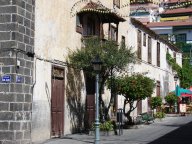
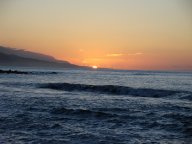
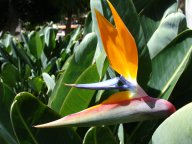



Located on the north coast of Tenerife, within the Orotava Valley, Puerto de la Cruz is the principle tourist centre of the island. A cosmopolitan, old colonial town known to tourists from all over Europe and beyond. For North Europeans it is the place to escape to from long cold winter nights. For South Americans a more pleasant climate than the harsh summer back home. For Peninsular Spanish a place to escape to from the harsh summer sun in Mainland Spain.
Although no longer seen as an exotic location, Puerto de la Cruz still manages to attract some 900,000 visitors each year.
Unlike too many Spanish resorts, Puerto de la Cruz is no concrete jungle, though it does have an ugly modern part, but even here there are pleasant streets to explore. It has its own long history as a major port for the Orotava Valley and as fishermen's haven. The old part, the core of the old colonial town, is a network of tree lined avenidas, narrow winding calles, shady plazas and steps running from one level to another. Many of the fine old houses with their distinctive Canarian balconies have survived. La Paz, the most recent development on the outskirts of town, is an example of what can be done with a new development.
The importance of Puerto de la Cruz as a major tourist resort dates from long before the late 20th century boom in mass tourism. 19th century physicians, especially those in England and the Netherlands, recommended to their patients that they spent the winter here for the good of their health. Several of the resort's oldest hotels date from this earlier tourist industry.
The port of Puerto de la Cruz, together with that of Garachico, were the two main ports of the island. The port was principally used for the export of wine and as a fishing port. The local fisherman still use the harbour. Garachico lost its port, and most of the town during a volcanic eruption. The main shipping port for the island is now Santa Cruz, a main port of call for ocean liners.
The town is a shoppers paradise. The "free port status" which the island enjoys allows imports from all over the world. A very large variety of goods are available from many hundreds of shops, often at good prices. Especially cheap are electronic items of every description, photographic gear, perfumes and alcohol. The shopper should though always be on their guard as cheap is often cheap and tacky.
Shoppers should take note of the tendency of many Taiwanese and Chinese companies of naming and packaging their products in a manner that bears a striking similarity to well known Japanese brands. Be on your guard for counterfeit goods. One of the latest scams is to show you the genuine item, then behind the scenes pack a fake. Therefore insist on seeing what is within the packaging before parting with your money and before leaving the shop. Always have a witness with you. Paying by credit card affords some protection. When buying always ensure that you are given an international guarantee.
Shoppers and visitors should also be very wary of the touts on the streets. What they are offering is not a bargain and contrary to the claims made as to the authentic nature of their goods what is being hawked is usually cheap tacky imitations. The time share sharks are also to be avoided. Never attend a meeting organised by timeshare touts, no matter what prize it is claimed you have won. If you want to buy a property visit one of the estate agents to be found in town, and consult a lawyer. Visitors come to Puerto de la Cruz to relax, not to be harassed by bums on the street. More needs to be done to clear this scum of the streets.
Spain has refused to implement EU directives on time share, Tenerife and the Canary Islands have introduced regulations that are a weaker version of the EU directives. The advice of the British Government is simple: Do not buy timeshare in Spain.
In recent years muggings and other street crimes have started to become a problem. It is not of the scale of Playas las Americas, or cities in Northern Europe. It is still safe to walk the streets, even late at night and in the early hours of the morning, but visitors should take sensible precautions like keeping a firm grip on their bags and other belongings and not flaunting valuable possessions. Thefts from cars, especially cars left overnight and cars left in what appear to deserted scenic locations, have become a major problem. Do not temp fate and leave anything of value in an unoccupied car.
One of the biggest problems walking the streets is the mess dogs leave on the streets and the failure of dog owners to clean up behind them. Be careful where you tread.
Crossing the road one takes one's life in one's hands. No respect is given to pedestrian crossings, not even controlled crossing.
As to be expected for a major tourist location the town contains a large number of hotels. The standard, in particular the level of service and the quality of the meals is often poor by International standards. In too many hotels client satisfaction appears to be an alien concept. The rare exceptions are the privately owned and managed hotels where the hoteliers take immense pride in their hotels. The poor quality of many of the hotels in particular the hotel management has been officially recognised and improvements form part of the overall Tourist Development Plan for the Orotava Valley.
The independent OAG Agent's Gazetteer 1998 gives an idea of what to expect:
Accommodation: Weighting in favour of hotels rather than apartments, most of them in the middle range of quality, some of the 4-stars are are not worthy of their rank.
With growing competition from other countries, it is now not uncommon to find large hotels with 2-3 floors empty during the peak season. Hotel staff are becoming increasingly worried as to their jobs in the future.
In contrast to the hotels the many restaurants in Puerto de la Cruz serve excellent meals. The owners and staff take a great pride in their dishes and the quality of service. Outside of Puerto de la Cruz the food in any bar is usually excellent. [see Eating out in Puerto de la Cruz]
For the best food, restaurants out of town in out-of-the-way places, frequented by locals, not tourists.
The exception to the poor quality service in many of the hotels are the small 3-star and family run hotels where great pride is taken in the hotel.
In many ways Tenerife has lost the plot. For the winter it was one of the few places to be able to catch winter sun, so hoteliers did not care, they always had full hotels. But in recent years, something like 100,000 beds have come on-stream in Tunisia, Algeria, Morocco, Egypt and Turkey, offering quality service at half the price, plus people are now willing to travel much further afield to south east Asia, Africa, Florida, Bahamas, Jamaica, Cuba and even South America. No small wonder then, that during February, when hotels have traditionally been overbooked, some 4-star hotels are now only 80% full.
All hotels, bars, cafes and restaurants hold an official complaints book, hoja de reclamaciones, they are also required to display a prominent notice to that effect. Both are legal requirements. If you have a complaint, request the book, actually a set of loose leaf pages. Once filled out, a copy is retained by the establishment, a copy goes to an official agency that will investigate the complaint, and the third copy is kept by the person lodging the complaint. The very act of requesting the book can often work wonders, but do not be deterred from filing a complaint.
Puerto de la Cruz hosts a major international festival - La Carnaval. A smaller version of its big brother in Santa Cruz, but on a more human and friendlier scale. The whole town comes alive every night. People are on the street until the early hours of the morning. Everyone is in fancy dress. A group of friends or a family will pick a theme, the theme changes every night. The middle of the carnival coincides with Ash Wednesday, in Puerto de la Cruz this is the night of the Funeral of the Sardine. A large figure of a sardine is carried through the town to be burnt on a funeral pyre in the harbour, followed by a spectacular fireworks display. The girls are dressed in black, their faces daubed in ash, a posy of white flowers in their hands. It can be a frightening spectacle as they roam wailing through the streets.
La Carnaval opens with a procession on one weekend, and closes with a large procession on the following weekend. For the closing procession everyone takes part. Before the start of the carnival a competition is held to find the best dressed participants and to elect a Carnival Queen. Every night various South American Salsa bands play in Plaza del Charco. Around the square and lining the side-streets are to be found booths selling food, drinks trinkets. Loud music blasting from the booths, each one playing a different tune. One night of rest. This is when everyone decamps to Santa Cruz to watch and participate in the big event.
During La Carnaval stalls selling food set up in the main square and by the harbour. Food is served during the day and early evening.
You have not lived until you have danced the night away at La Carnaval.
Besides La Carnaval there are several other festivities. One of the strangest is 'the Night of the Tin', that takes place on St Andrew's Night, 29th of November. St Andrew's Night, is the night that the cellars are traditionally opened and the new wine sampled. On this night the young of the town run around like crazy dragging behind them bits of tin on a string. These bits of tin, can be anything from a few Coke cans, a tin bath, to a car door. The racket generated is horrendous. The significance of this event I have never been able to discover.
Apart from the festivities associated with the various carnivals, Puerto de la Cruz also plays host to a major international ecological film festival.
Outside of carnival time the town is by no means dead, though it can seem that way when La Carnaval has just ended. There are a large number of bars, discos and night clubs of sufficient number and variety to suite all tastes and perversions.
Several BookCrossing zones can be found in Puerto de la Cruz. The local library, libraries in hotels where guests exchange books, a net café, a restaurant, a bench in a shady plaza.
BookCrossing zones are locations where books are released into the wild, their progress tracked through the Internet via a unique BookCrossing ID (BCID).
There is a lot to see and worth seeing in Puerto de la Cruz. Two leisurely half day strolls around the town should more or less cover everything.
Every pueblo in Spain has a Plaza Major, that is a main square or meeting place. In Puerto de la Cruz the Plaza del Charco is the heart of the town. Its name derives from a pool of sea-water that used to collect in its middle. It has always been a meeting place, although it is only since the 18th century that it has functioned as a plaza.
In the centre of the plaza is a pool and fountain full of large green vegetation (yams). The shade from its Palm Trees and the Indian Laurels brought back from Cuba in 1852 make the plaza a pleasant place to sit and watch the world go by. The stone benches took root in 1851. During La Carnaval it is the heart of the carnival, a very lively place to be. On a Sunday it is full of promenading locals all decked out in their Sunday finery.
On the West side of the plaza there are some fine examples of 18th century Canary architecture - balconies and inner courtyards. To the North and just below the plaza is the harbour.
On the South side, there ascends the pedestrian street of Calle Blanco, it contains various shops selling electronics and tourist click-clack - of little interest other than the fact that it is named in honour of Nicolas White who after many long years of sojourn in the town, hispaniziced his surname and became the first Mayor of Puerto de la Cruz in 1772.
Though no longer seen on street signs or street maps, the square's full name, and the name by which it was known in the previous century is La Plaza del Charco de los Camarones. So named due to the shrimps that could be caught in the pool of brackish water that collected in the middle. A painting dating from the early part of the 19th century shows a large open square, a pool of water in the middle, and not a tree in sight.
There used to be a giant chess set in one corner of the plaza, a drinking fountain in another. Sadly neither of these remain today - it can be but hoped that in the attempts to improve the town these two features will be brought back.
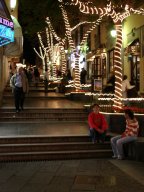 Calle de Quintana ascends some steps on the east
side of the plaza. It runs from the Plaza del Charco through the
Plaza del Doctor Victor Pérez through the Plaza de Iglesia and on
to La Punta del Viento. At the foot of the steps is a bust to
Domingo Pérez Trajillo (1890-1994), inscribed as un hombre bueno (a good man).
Calle de Quintana ascends some steps on the east
side of the plaza. It runs from the Plaza del Charco through the
Plaza del Doctor Victor Pérez through the Plaza de Iglesia and on
to La Punta del Viento. At the foot of the steps is a bust to
Domingo Pérez Trajillo (1890-1994), inscribed as un hombre bueno (a good man).
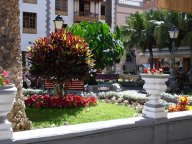 The Plaza del Doctor Victor Pérez is a very
quiet peaceful little garden, seats shaded by Palm Trees, in the
centre a pool and fountain. The plaza was constructed in 1904 in
honour of a local doctor, a pioneer of tourism, who was one of
the principal promoters of the Gran Hotel Taoro (now the Casino Taoro).
The Plaza del Doctor Victor Pérez is a very
quiet peaceful little garden, seats shaded by Palm Trees, in the
centre a pool and fountain. The plaza was constructed in 1904 in
honour of a local doctor, a pioneer of tourism, who was one of
the principal promoters of the Gran Hotel Taoro (now the Casino Taoro).
On one side of the Plaza de Victor Pérez is the Iglesia de San Francisco, formerly the Ermita de San Juan Bautista siglo XVI (chapel of St John the Baptist) built between 1598 and 1608 by the Tax Collector Juan de Tejera and dedicated to Saint John the Baptist. It is the oldest religious, and civil building in Puerto de la Cruz, apart from the hermitage of La Paz. It was given over to the Franciscans in siglo XVIII.
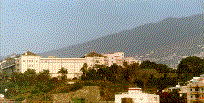 La Calle San Juan leads up to la Plaza
Concejil. In the distance towering over the town can be
seen the Casino Taoro. From the Plaza Concejil it is possible to
continue onwards and upwards and climb up to the Casino Taoro, or
to turn right, along to Calle Blanco, and back down to La Plaza del Charco.
La Calle San Juan leads up to la Plaza
Concejil. In the distance towering over the town can be
seen the Casino Taoro. From the Plaza Concejil it is possible to
continue onwards and upwards and climb up to the Casino Taoro, or
to turn right, along to Calle Blanco, and back down to La Plaza del Charco.
A little further up the Calle de Quintana on the corner with Calle Agustín de Bethencourt is the Parque de San Francisco where the town's cultural and festive events take place. It is on the site formerly occupied by the Franciscan Convent and is at the back of the Iglesia de San Francisco. The convent was destroyed by fire in 1967.
Facing the entrance to the Parque de San Francisco are the present headquarters of the Red Cross - Casa de la Cruz Roja. An important club in the 17th century. Manual Antonia de la Cruz (1750-1809) painter lived here. It was the birthplace of his son, Luis de la Cruz y Rios, royal mayor of Puerto de la Cruz, director of La Laguna Academy and court painter to Fernando VII. The exterior is of little interest, inside an open courtyard with balconies. Unusual for a courtyard, it is not overgrown with foliage. Not open to the public.
On the opposite corner stands the Instituto de Estudios Hispánicos de Canarias (Institute of Hispanic Studies of the Canaries), a cultural centre where conferences, exhibitions and courses for foreigners are held. It has a library which may be visited in the afternoon. Just past the Instituto along the c/ Agustín de Bethencourt is the town's Public Library.
Continuing along Calle de Quintana we arrive in the Plaza de la Iglesia. If the Plaza del Charco be the heart of Puerto de la Cruz then la Plaza de la Iglesia is its soul. A pleasant shady spot under the Palm Trees, a small fountain in the centre, dominated by the church, surrounded by interesting old buildings on all sides, most noticeable of which are the two hotels Marquesa and Monopol and the Colegio Tomos Iriarte.
La Iglesia de Nuestra Señora de la Peña de Francia dominates the plaza. Originally a small chapel built in 1603 by the Regidor Franchy Lutzardo. Between 1620 and 1621 the inhabitants of the town became aware of the need to convert the chapel into a church. Matheo de Sosas started the work in 1684 with a capital of 30 pesos, the work was completed in 1697. The tower dates from 1898. The tower contains an artistic legacy, the most noteworthy of which is the image of the Gran Poder de Dios (17th - 18th century) and the paintings of the pulpit, executed by the local artist Manuel de la Cruz.
The Hotel Marquesa was built in 1712, former residence of the Marquesa de la Candia, it became a hotel in 1887. Although renovated in 1995 the rooms have still managed to retain their 19th century charm. Inside traditional Canarian architecture, hand carved balconies. The Marquesa is one of the few remaining hotels from the 19th century tourist industry. The hotel has produced an excellent illustrated book of the history of the hotel that also serves to illustrate the history and development of Puerto de la Cruz - El Hotel Marquesa (en español solamente).
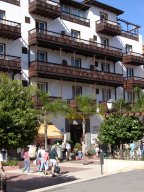 The Hotel Monopol, like the adjacent Hotel
Marquesa, is one of the few remaining hotels from the 19th
century tourist industry. Built in 1742, it became a hotel in
1888. The present owners and managers, the Gleixner family, took
over in 1928. The flowers laid across the doorway always catch
the eye of the passers-by. Inside traditional Canarian
architecture with balconies.
The Hotel Monopol, like the adjacent Hotel
Marquesa, is one of the few remaining hotels from the 19th
century tourist industry. Built in 1742, it became a hotel in
1888. The present owners and managers, the Gleixner family, took
over in 1928. The flowers laid across the doorway always catch
the eye of the passers-by. Inside traditional Canarian
architecture with balconies.
In the plaza, facing the Monopol, stands the bust of Agustín de Bethencourt y Molina (1758-1824), who was born in the hotel. An army engineer he reached the rank of General in the Russian Imperial Army during the reign of Tsar Alexander I, and was Director General of Ports and Roads of the Russian Empire under Tsar Alexander II. Inventor of a silk weaving machine and a steam machine of double action. He was founder and first director of the School of Canals and Roads in Madrid (School of Civil Engineering).
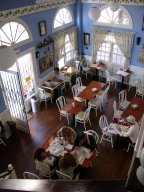 The Plaza de la Iglesia did contain the tourist office, this has
now moved to the Plaza de Europa. The tourist office has since moved again, and is now located in the old Customs House on the side of the harbour.
The Plaza de la Iglesia did contain the tourist office, this has
now moved to the Plaza de Europa. The tourist office has since moved again, and is now located in the old Customs House on the side of the harbour.
Tucked away in the back streets behind the Plaza de la Iglesia used to be a German tea shop. One of the few places in Puerto de la Cruz, if not Tenerife, where they knew how to make a decent cup of tea. The cakes were pretty good too. Sadly it is no longer there and for some years the premises were sitting derelict, now an apartment block.
Two streets behind Plaza de Iglesia, is El Limón. El Limón is an excellent vegetarian restaurant, the food is good, as are the fruit juices made from fresh fruits. The interior is very open and spacious. A pleasant place to relax on a hot day, if only for a refreshing fresh fruit juice.
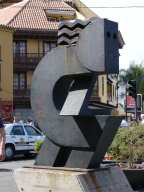 Continuing on from the Plaza de la Iglesia we arrive at he
terrace of the Punta del Viento, so called
because it is facing the prevailing wind. From here there are
fine views along the coast. Looking below the terrace, can be
seen the natural rock pools of Playa de San Telmo. Looking out
along the coast is an interesting sculpture. One of many fine
examples that art is alive and well in Puerto de la Cruz to be
found dotted around the town.
Continuing on from the Plaza de la Iglesia we arrive at he
terrace of the Punta del Viento, so called
because it is facing the prevailing wind. From here there are
fine views along the coast. Looking below the terrace, can be
seen the natural rock pools of Playa de San Telmo. Looking out
along the coast is an interesting sculpture. One of many fine
examples that art is alive and well in Puerto de la Cruz to be
found dotted around the town.
From Punta del Viento there is a choice of routes, turn left and go down the Calle de Santo Domingo, or continue onwards through the Calle de San Telmo, often referred to as the Paseo de San Telmo on account of it being pedestrianised, and on to Ermita de San Telmo.
The Paseo de San Telmo is the town's promenade.
Looking back towards the Punta del Viento and a little to the
right, the old walls of the convent can be seen, atop are the
Casas Consistoriales.
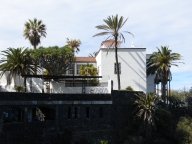
The old convent that used to exist on the site gave its name to the street. Originally there existed here a hermitage, handed over to the friars of the Order of Santo Domingo who later built the Dominican convent of San Pedro González Telmo, the work being finished about the year 1659. In 1778, on the night of 19th of December, the convent and a large part of the town were destroyed by fire. The convent was partially rebuilt between 1781 and 1786 by the architect José de Bethencourt y Castro.
Owing to the process of alienation in 1837 the convent became property of the State and later that of private persons.
The Casas Consistoriales are located on plots belonging in former times to the Convent of San Pedro González Telmo. These were built in 1973. At the entrance of the building can be seen the coat of arms of the town, designed by Monseigneur Bruno Helm - the green dragon, with a red tongue, mythical guardian of the garden of Hesperides, beyond the columns of Hercules, the Eden of the three nymphs of gold; upon its back, the Latin cross, in red; the cross of the Puerto (Port) which completes its name and traditions; under the claws of the Dragon, the field of zure and three scalloped bands of silver, the navigating waves, roots of the town as a means to trade and expansion; superimposed, the key in sable which opens the way to the routes of the Indies; on the crest, the crown, the reflection of the monarchy of the Catholic King and Queen.
Along the way we pass the Playa de San Telmo and its natural rock pools. Scattered amongst the rock pools are to be found attractive females displaying their attributes to the sun, lining the promenade, taking advantage of such a convenient viewpoint, is to be found many a male casting an admiring glance or two.
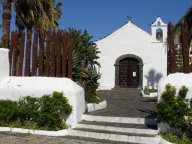 At the end of the Paseo de San Telmo is the Ermita de San Telmo,
situated on the Caleta or Fondeadero Cliffs. Founded in 1780 by
the Mareantes Guild and dedicated to the Dominican friar San
Pedro González de Fromista or San Pedro Telmo, patron saint of
seamen. The present image of the saint dates from the end of the
18th century. Beneath the floor of chapel are the bodies
of the victims of the flood, a consequence of the great storm of 1826.
At the end of the Paseo de San Telmo is the Ermita de San Telmo,
situated on the Caleta or Fondeadero Cliffs. Founded in 1780 by
the Mareantes Guild and dedicated to the Dominican friar San
Pedro González de Fromista or San Pedro Telmo, patron saint of
seamen. The present image of the saint dates from the end of the
18th century. Beneath the floor of chapel are the bodies
of the victims of the flood, a consequence of the great storm of 1826.
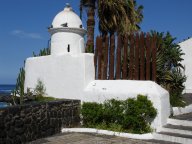 The chapel is situated within the grounds of a small square. This
was the San Telmo Battery, currently there remains some
traces of the sentry boxes and the teak fences which encircled it.
The chapel is situated within the grounds of a small square. This
was the San Telmo Battery, currently there remains some
traces of the sentry boxes and the teak fences which encircled it.
The battlements overlook the Plaza de Europa, the rock pools and the lido. Considering the hustle and bustle that is only a few metres away, this little plaza is a surprising oasis of peace and tranquillity.
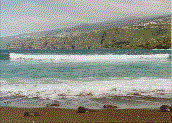 Continuing further along the coast, along the pleasant tree lined
Avenida de Colón, past the lido, the
Playa Martiánez is reached. The beach is
nothing special, its only noteworthy feature is the stunning
views along the coast. Looking back into the town can be seen the
mouth of the Barranco Martiánez. This is the modern
part of town, hideous and ugly, full off shops selling overpriced
junk to gullible tourists.
Continuing further along the coast, along the pleasant tree lined
Avenida de Colón, past the lido, the
Playa Martiánez is reached. The beach is
nothing special, its only noteworthy feature is the stunning
views along the coast. Looking back into the town can be seen the
mouth of the Barranco Martiánez. This is the modern
part of town, hideous and ugly, full off shops selling overpriced
junk to gullible tourists.
Part way along the Avenida de Colón is the Café Columbus from which free transport to various tourist traps depart. The Café Columbus actually no longer exists, but the spot where it did exist is still referred to as the Café Columbus! The Avenida de Colón is usually lined with street vendors. Most are selling junk, but a few are worth a second glance. The Blacks found here and in other parts of town are selling fake and counterfeit goods.
Tracing our steps backwards we return to the Punta del Viento, looking back towards c/ Quintana and on the corner with c/ de Santo Domingo is a modern building built in Canarian style Edificio Quintana. Now continue down the cobbled c/ de Santo Domingo.
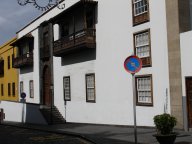 Immediately on the right is the Casa Rahn, Siglo
XVIII (18th century) built on the site of the former Dominican Convent.
Rodriguez Figueroa (1875-1956) lawyer, writer and poet lived here.
Immediately on the right is the Casa Rahn, Siglo
XVIII (18th century) built on the site of the former Dominican Convent.
Rodriguez Figueroa (1875-1956) lawyer, writer and poet lived here.
Further down the street, lining the left hand side are the traditional Tenerifan flower sellers. On the right the Ayutamiento.
The Ayutamiento (town hall) is a modern building constructed in 1973. Although not officially open to visitors it is a public building that is well worth a look inside. The Ayutamiento also houses the Municipal Police. The Ayutamiento is on one side of, and overlooks the Plaza de Europa.
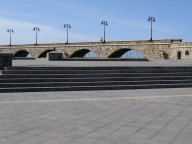 La Plaza de Europa is a modern construct, bleak
and treeless - none the less quite attractive - though best
avoided in the middle of a hot and sunny day. Its battlements
afford good views along the coast and back into the town, and of
the distant valley. Mounted on the battlements are a number of
cannons. Evenings, and especially weekends, the plaza is used by
the local kids as an unofficial skate park. In one corner the
Ayutamiento (Town Hall). The tourist office, la oficina de
turismo, can be found on one side, beneath the battlements. The
tourist guides to be found within are always very helpful.
La Plaza de Europa is a modern construct, bleak
and treeless - none the less quite attractive - though best
avoided in the middle of a hot and sunny day. Its battlements
afford good views along the coast and back into the town, and of
the distant valley. Mounted on the battlements are a number of
cannons. Evenings, and especially weekends, the plaza is used by
the local kids as an unofficial skate park. In one corner the
Ayutamiento (Town Hall). The tourist office, la oficina de
turismo, can be found on one side, beneath the battlements. The
tourist guides to be found within are always very helpful.
The name does not indicate any desire for unity in Europe. On the contrary, Tenerifans are as fiercely independent as the people of other countries. First and foremost they are Canarians, or Tenerifans, a very long way second are they Spanish. In truth, the name is a sop to the EU in recognition of the huge amount of funding that has been poured into Tenerife. The EU paid for the creation and landscaping of Playa Jardín, and are currently paying for the extension and modernisation of Auropuerto Reina Sofia (Tenerife Sur).
A noticeable piece of graffiti to be found all over Tenerife is a spiral, and sometimes in English, as if to make the point 'Spanish Go Home'. A popular saying is - Canarias no es Europa, somos Africanos - the Canaries are not Europe, we are Africans. Heroes of the liberation of South America are frequently celebrated in Tenerife as heroes. Although granted a degree of autonomy by Madrid, Canarians see themselves as an oppressed colony, who deep in their hearts are yearning for their own liberation.
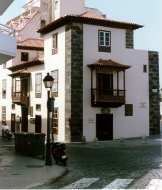 Here the street divides in two on either side of
Casa de Miranda,
Siglo XVIII (18th century), c 1780. Lived in by the parents of
Francisco de Miranda y Rodriguez de Espinosa (1750-1816) hero of
the Venezuelan fight for independence. The house is now a
restaurant (the food is not too good).
Here the street divides in two on either side of
Casa de Miranda,
Siglo XVIII (18th century), c 1780. Lived in by the parents of
Francisco de Miranda y Rodriguez de Espinosa (1750-1816) hero of
the Venezuelan fight for independence. The house is now a
restaurant (the food is not too good).
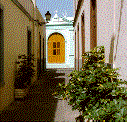 Continue down the pedestrianised, cobbled street
Calle de las Lonjas, so
named because the majority of the towns fishermen traditionally
lived in this quarter, and on to the Puerto Pesquero. Halfway
down the street, opposite c/ Pacheco is
a charming little chapel. This is one of many small chapels
found in the old part of Puerto de la Cruz. Towards the end of
the street, before it opens out into the harbour is a small
block of warehouses used by the fisherman.
Continue down the pedestrianised, cobbled street
Calle de las Lonjas, so
named because the majority of the towns fishermen traditionally
lived in this quarter, and on to the Puerto Pesquero. Halfway
down the street, opposite c/ Pacheco is
a charming little chapel. This is one of many small chapels
found in the old part of Puerto de la Cruz. Towards the end of
the street, before it opens out into the harbour is a small
block of warehouses used by the fisherman.
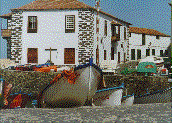 Immediately past the warehouses and sitting on the harbour side
is the Casa de la Real Aduana or Royal Customs
House. It was founded in 1620 and is the oldest civic building
in Puerto de la Cruz. It was known for many years as Casa de los
Franchy. It was later leased to the Royal Exchequer to house the
Customs Officers or administrators until 1833, when the former were
transferred to Santa Cruz de Tenerife. The Customs House stands
within what was the Batería de Santa Bárbara. At
the rear of the Customs house the remains of the battery still
exist with steps (constructed in 1741) leading down into the
water. The Batería was a small fort built in 1708 to protect the
harbour. It housed four cannon. The Batería existed until the
beginning of this century, but in view of the number of vessels
coming in to load fruit, the Mayor requested the military
authorities to demolish the stockade and the sentry box to enable
the lorries carrying these goods to operate more easily.
Immediately past the warehouses and sitting on the harbour side
is the Casa de la Real Aduana or Royal Customs
House. It was founded in 1620 and is the oldest civic building
in Puerto de la Cruz. It was known for many years as Casa de los
Franchy. It was later leased to the Royal Exchequer to house the
Customs Officers or administrators until 1833, when the former were
transferred to Santa Cruz de Tenerife. The Customs House stands
within what was the Batería de Santa Bárbara. At
the rear of the Customs house the remains of the battery still
exist with steps (constructed in 1741) leading down into the
water. The Batería was a small fort built in 1708 to protect the
harbour. It housed four cannon. The Batería existed until the
beginning of this century, but in view of the number of vessels
coming in to load fruit, the Mayor requested the military
authorities to demolish the stockade and the sentry box to enable
the lorries carrying these goods to operate more easily.
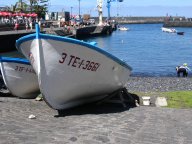 Puerto Pesquero (Fishing Port) consists of two
breakwaters to give protection to the town, and to the small
fishing craft that anchor in the harbour. During the 7th and 8th
centuries the port was of great importance for the Island. 80% of
all exports passed through the Port of Orotava, as it was then known.
Puerto Pesquero (Fishing Port) consists of two
breakwaters to give protection to the town, and to the small
fishing craft that anchor in the harbour. During the 7th and 8th
centuries the port was of great importance for the Island. 80% of
all exports passed through the Port of Orotava, as it was then known.
From the far side of the harbour there is a fine view across the harbour of the Casa de la Aduana and up the Las Lonjas. There is also a fine view through the Calle de María into the Plaza del Charco, on a fine day El Teide can be seen in the background. It is but a short stroll through the c/ de María back into Plaza Charco.
The general ambience of the harbour has recently been spoilt by a monstrosity of a building, ironically erected to display Tenerifan arts and crafts. The money spent on this monstrosity would have been better spent on renovating one of the town's many old buildings. The sooner it is demolished and good taste prevails the better.
From the harbour it is a very pleasant walk along the sea wall to Playa Jardín and on to Punta Brava. From the sea wall there are stunning views both along the coast and inland back into the town with the Orotava Valley and El Teide in the background. Midday is best avoided, and be aware that the wall can be very dangerous during rough seas. In the evening, the sea-wall affords spectacular sunsets looking towards Playa Jardín and across to Punta Brava.
If you take the walk along the sea wall, or alternatively go along the narrow coastal road that leads out from the waste ground alongside the harbour that serves as a car park, as you near the end of the wall, you will pass by the back of the town's football pitch and the municipal swimming pool. You will then reach a breakwater, with the Playa Jardín opening out before you.
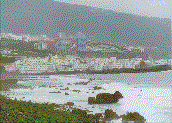 The breakwater is a great place to sit and watch the world go by.
Stretching out in front is the Playa Jardín, in the distance Punta
Brava, and beyond on the hillside Los Realejos.
In the far distance, further along the coast, can be seen
San Juan de la Rambla.
Looking inland the amphitheatre of the Orotava Valley can be
appreciated, on a clear day El Teide can be seen towering above
the ridge. Behind is the Castillo de San Felipe. The view
across the valley has recently been spoilt by the construction of
the Hotel Turquesa on the old banana plantations. Its sombre
grey aspect dominates the view, looking more like the
headquarters of the security police in a totalitarian regime than
a luxury hotel. The breakwater is a favourite spot for locals on
a Sunday evening to sit and watch the sun go down at the end of the day.
The breakwater is a great place to sit and watch the world go by.
Stretching out in front is the Playa Jardín, in the distance Punta
Brava, and beyond on the hillside Los Realejos.
In the far distance, further along the coast, can be seen
San Juan de la Rambla.
Looking inland the amphitheatre of the Orotava Valley can be
appreciated, on a clear day El Teide can be seen towering above
the ridge. Behind is the Castillo de San Felipe. The view
across the valley has recently been spoilt by the construction of
the Hotel Turquesa on the old banana plantations. Its sombre
grey aspect dominates the view, looking more like the
headquarters of the security police in a totalitarian regime than
a luxury hotel. The breakwater is a favourite spot for locals on
a Sunday evening to sit and watch the sun go down at the end of the day.
A favoured pastime of Tenerifans, faintly surreal and reminiscent of Douglas Adams' Hitch Hikers Guide to the Galaxy, is the Tenerifan habit of constructing and redesigning beaches. The beach at Playa Las Americas was constructed by importing sand from the Sahara, the intention was to create a golden beach, though now it is a dirty grey. The beach outside Santa Cruz, Playa de las Teresitas, was also an artificial construct, unlike Playa las Americas it has managed to retain its golden appearance. The Playa Jardín is further example of beach reconstruction. The design was that of the Canarian Artist, César Manrique, and he has made a good job, working with nature not against.
Large blocks of rocks were dropped across the bay to form a semi-natural breakwater. These removed much of the force and momentum of the Atlantic rollers that come thundering in, so tall that they are more like multi-storey tower blocks running across the sea. The surroundings consist of walkways, gardens, a bandstand, waterfall, games areas and a play area for children, plus several beach cafes. The sand is the native black Tenerifan volcanic sand. This has been added to by crushing large rocks. Whilst the natural black sand is fine, the artificial stuff is more lack the remnants of a building site. Given several centuries of interaction with the sea, the artificial stuff will be fine too. The area is especially popular with locals, and on a Sunday they will be found promenading in their Sunday best, well into the evening.
On the edge of the Playa Jardín, between the beach and the town, is the Castillo de San Felipe.
The Castillo de San Felipe, otherwise known as the Old Port Castle, is a 17th century colonial style fort which used to protect the town from attacks by corsairs and pirates. It is one of three fortifications which used to exist in the town.
Built under Phillip IV between 1630 and 1644. Subsequently abandoned and allowed to fall into ruin after the flood of 1826, as its original purpose as a defence against English privateers was no longer needed.
Apart from guarding the town, the castle also guarded a small harbour located at the mouth of the Barranco de San Felipe. It was this that gave the castle its original name - Castillo del Puerto Viejo.
Castillo de San Felipe is now used as a cultural space for exhibitions, music recitals and drama.
Emptying into the Playa Jardín is the Barranco de San Felipe, now a dry river-bed, but not always so. The source of the dried up river is high up the valley. Just before La Vena it divides in two, one branch flowing through Los Realejos, the other flowing through Puerto de la Cruz and emptying into Playa Jardín. Great floods have swept through the ravine in 1677, 1826, 1879, 1901 and 1918.
With the wealthy families controlling the best land, poor families were forced to build on the edge of and within the ravine. In the great flood of 8th November 1826, caused by a storm that broke over the valley as the day dawned, crops and houses were swept away, Plaza del Charco was covered in trees, rocks, mud and other flood debris, the debris stretched 250 metres into the sea, putting at an end Puerto Viejo - 14 lives were lost.
Castillo de San Felipe currently serves as a Cultural Arts Centre. It is the venue for small concerts and recitals, and used to mount small art exhibitions.
From Playa Jardín we can walk on to Punta Brava, or return to the Plaza Charco via the back streets. The back streets are an interesting route as you will enter a maze of back alleys and small plazas. It is in this old part of town, as you approach the harbour, that many of the best restaurants are to be found.
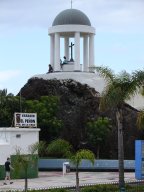 Before a choice of routes is met and at the point where the road
divides into two is the folly of El Peñón del Fraile,
set atop an outcrop of
volcanic lava. El Peñón is a favoured spot of football
supporters. This is not out of any great homage to the monument,
but because it gives a superb, gratis, birds-eye view of the match.
Spoil-sports have erected a screen across the end of the ground in
an attempt to impede this grandstand view.
Before a choice of routes is met and at the point where the road
divides into two is the folly of El Peñón del Fraile,
set atop an outcrop of
volcanic lava. El Peñón is a favoured spot of football
supporters. This is not out of any great homage to the monument,
but because it gives a superb, gratis, birds-eye view of the match.
Spoil-sports have erected a screen across the end of the ground in
an attempt to impede this grandstand view.
El Peñón del Fraile got its name from a friar or fraile who used to climb to the top of the rock, or peñón, every day to pray.
The ravages of time, the weather, and hordes of football fans are literally causing El Peñón to crack up. There is currently a campaign to give El Peñón a face-lift before it collapses.
Of the two routes back into town, c/ de Mequinez and c/ de San Felipe, the lower is possibly the more interesting, though there is not a lot in it. Both offer a better way into town, than the sea wall during the day, as it is possible to get a little shade by hugging the sides of the buildings. It is also better than the main road a little higher up as it avoids most of the traffic.
The two narrow back streets, c/ de Mequinez and c/ de San Felipe, that lead into town are lined with traditional houses. Not the grand mansion houses of the rich, but small white squat houses with small windows and thick walls. The interior is often open, enclosing a small shady courtyard. The top of the house is often left unfinished, as the family grows the house grows too by adding on another floor.
Sandwiched between the two bottom roads is a third road - Calle de Lomo. A conscious effort has to be made to divert to this road otherwise it is always bypassed, no matter which route is taken. Along this middle road is the municipal archaeological museum.
Only a few one hundred metres from the Plaza del Charco, in the middle of what used to be the fishermen's quarters, is the Museo Arqueológico Municipal. This is the heart of the restaurant district. The museum is housed within a 19th century Canary mansion house.
The museum opened in 1991 although its roots go back to 1953 when the Archaeological Museum of the Institute of Spanish Studies of the Canaries was created.
The exhibits include an interesting collection of aboriginal ceramics and other utensils, remains of mummified Guanches, 17th century maps, etc. It also houses an interesting exhibition illustrating what is known or postulated of Guanche lifestyle, in particular their religious ceremonies, and how they made pots.
The Archaeological Museum is well worth a visit.
Also near the Plaza del Charco, en la Calle Pérez Zamora, is the Instituto de Formación Profesiónal - a vocational training polytechnic - Siglo XVIII y XIX (18th and 19th Cent). When closed, huge wooden doors are across the entrance, inside an open courtyard surrounded by balconies.
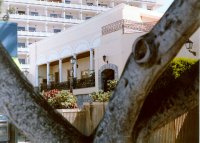 A couple of minutes further on past the Instituto, es la estación
de guaguas (bus station). From here there is a good bus
service to all parts of the island. Continue up past the side of
the bus station, and opposite the Hotel Dania Park is another school.
A couple of minutes further on past the Instituto, es la estación
de guaguas (bus station). From here there is a good bus
service to all parts of the island. Continue up past the side of
the bus station, and opposite the Hotel Dania Park is another school.
Previously we were faced with a choice of routes from la Plaza de Victor Pérez and chose to continue along the Calle de Quintana. This time we shall go from the plaza along la Calle San Juan up to la Plaza Concejil.
Before reaching la Plaza Concejil, on the right hand side of c/ San Juan is the Casa Reimers, 18th century (siglo XVIII). The Reimers family were the last owners. On the exterior are fine examples of Canarian balconies.
La Plaza Concejil is surrounded by one of the best groups of preserved buildings in the town.
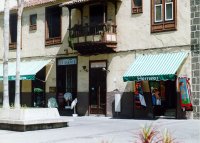 On the corner of la Calle San Juan and Calle Iriarte
is la Casa Iriarte (18th Cent), formerly home of
the Iriarte family. In it was born the renowned fable writer
Tomás de Iriarte y Nieves-Ravelo (1750-1791). A fine example of
traditional Canarian architecture. Balconies on the outside,
and inside an open courtyard with balconies. Downstairs, la Casa
Iriarte houses a lace museum. Upstairs, a naval museum, some
interesting old photos of old Puerto de la Cruz, a poster (c 1920)
describing Puerto and scale models of the islands.
On the corner of la Calle San Juan and Calle Iriarte
is la Casa Iriarte (18th Cent), formerly home of
the Iriarte family. In it was born the renowned fable writer
Tomás de Iriarte y Nieves-Ravelo (1750-1791). A fine example of
traditional Canarian architecture. Balconies on the outside,
and inside an open courtyard with balconies. Downstairs, la Casa
Iriarte houses a lace museum. Upstairs, a naval museum, some
interesting old photos of old Puerto de la Cruz, a poster (c 1920)
describing Puerto and scale models of the islands.
The naval museum is a couple of hours well spent. Many interesting artefacts, mock-ups of ships, plus a large amount of information on Nelson's ill-fated attack on Santa Cruz, including a detailed scale model of the area under attack.
Around the corner from Casa Iriarte, a little way along Calle Iriarte, just before the steps, on the left hand side, is Coco Rico, a vegetarian pancake house. The tables outside are a good place to take a break late afternoon when the setting sun shines along the street. Coco Rico is rapidly becoming a meeting place for alternative life-styles and free-thinking minds. There are two other vegetarian cafes, El Limón and El Mana, within a couple of minutes walk of Coco Rico. Sadly Coco Rico no longer exists.
Opposite la Casa Iriarte is la Casa Hermanos de la Cruz Blanca 18th century (siglo XVIII). Formerly Colegio Pureza de María, now the Centre of the Cruz Blanca Brotherhood.
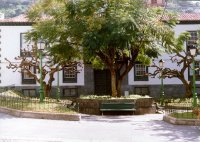 The south side of la Plaza Concejil is dominated by la
Casa-Palacio y Torreón de Ventoso (18th century).
Formerly (c 1750) the house of a merchant engaged in the import
export trade. The lower half of the house also served as a
warehouse, hence its substantial construction. In the 19th
century the house served as the Bremen Consulate.
La Palacio Ventoso is now the San Agustín religious college.
The south side of la Plaza Concejil is dominated by la
Casa-Palacio y Torreón de Ventoso (18th century).
Formerly (c 1750) the house of a merchant engaged in the import
export trade. The lower half of the house also served as a
warehouse, hence its substantial construction. In the 19th
century the house served as the Bremen Consulate.
La Palacio Ventoso is now the San Agustín religious college.
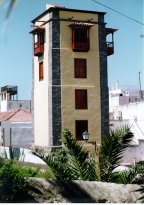 At the back of this house can be seen a tower -
Torreón Ventosa. It is an outstanding
example of its type, the only other comparable tower is at
Garachico. The tower has recently been reconstructed, though not
open to the public. The original purpose of the tower is reputed
to have been to enable the merchant to see approaching ships
before anyone else, nip down to the harbour and strike the best
deal - probably a tall tale.
At the back of this house can be seen a tower -
Torreón Ventosa. It is an outstanding
example of its type, the only other comparable tower is at
Garachico. The tower has recently been reconstructed, though not
open to the public. The original purpose of the tower is reputed
to have been to enable the merchant to see approaching ships
before anyone else, nip down to the harbour and strike the best
deal - probably a tall tale.
Leading out of la Plaza Concejil is the Calle Iriarte. On the corner with Calle Blanco is No 1 Calle Iriarte, siglo XVIII (18th Cent), formerly a Gentleman's Club.
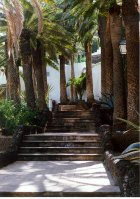 Follow Calle San Juan upwards out of the plaza, cross a narrow
busy road, and continue up a very pleasant tree lined flight of
steps. As you begin to ascend the steps, look back to get one of
the best views of Torreón Ventosa.
Follow Calle San Juan upwards out of the plaza, cross a narrow
busy road, and continue up a very pleasant tree lined flight of
steps. As you begin to ascend the steps, look back to get one of
the best views of Torreón Ventosa.
At the top of the steps, a row of very pleasant well kept houses, then an extremely unpleasant main road, which is very difficult to cross and you take your life in your hands in doing so. Opposite is a flight of steps that takes you up through the grounds of the Casino Taoro and up to the terrace overlooking the town.
This climb is no joke in the middle of the day. The gardens are long past their best and in urgent need of restoration. A few trees to give shade would be very welcome. On the way up, various rocky outcrops to sit upon. Take full advantage of the opportunity for a rest to look back and admire the view of the town that is unfolding below. Apart from the noise of the traffic below that keeps drifting up it is surprisingly peaceful and quiet. Running down through the gardens is an artificial stream and a collection of small rock pools. These are fed by a large waterfall at the top, which releases a large volume of water every hour or so, between times a tiny trickle. The whole effect is spoilt by the stream and pools being painted a swimming pool blue - urgh! Not helped by the water being very dirty and covered in scum. Sit still for a a while and large numbers of lizards come out. The air is alive with butterflies.
At the top, the Casino Taoro, and to the left Bello Risco. The climb is worth it, even in the heat of the middle of the day.
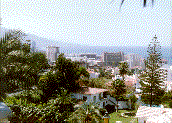
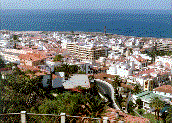
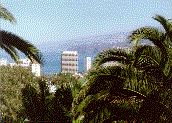
In front of the casino is a terrace, known as 'the Taoro Look-out'. It gives magnificent views over the town and out to sea. It would be a quiet spot, unfortunately the tranquillity is ruined by a cafe blasting out Muzak. Fortunately peace and quiet can be found not too far away in the Risco Bello.
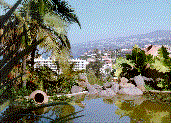 Risco Bello situated alongside the casino is a
lovely house and gardens. Although pricey, this is a favourite
spot to sit and relax for afternoon tea. The only sound in the
garden is the sound of bird-song. The garden is well tended,
butterflies add to the colour of the garden. Superb views over
the town and along the coast. Further into the garden are to be
found the water gardens. These are not worth visiting - poorly
landscaped and looking very artificial and out of place, pools
choked with green slime, looking more like thick pea soup,
goldfish barely able to move around and looking as though on
their last legs, a handful of mangy water-fowl, fountains
and waterfalls not working (the pumps need a rest!), lower down
the pools are in the shade and the fish do at least seem to be
enjoying life. The most interesting features are the lizards,
butterflies and dragonflies that have been attracted to the site.
Risco Bello situated alongside the casino is a
lovely house and gardens. Although pricey, this is a favourite
spot to sit and relax for afternoon tea. The only sound in the
garden is the sound of bird-song. The garden is well tended,
butterflies add to the colour of the garden. Superb views over
the town and along the coast. Further into the garden are to be
found the water gardens. These are not worth visiting - poorly
landscaped and looking very artificial and out of place, pools
choked with green slime, looking more like thick pea soup,
goldfish barely able to move around and looking as though on
their last legs, a handful of mangy water-fowl, fountains
and waterfalls not working (the pumps need a rest!), lower down
the pools are in the shade and the fish do at least seem to be
enjoying life. The most interesting features are the lizards,
butterflies and dragonflies that have been attracted to the site.
The water gardens were once praised by César Manrique as a 'Green Area of singular beauty', indicating that they must once have seen better days.
This whole area is known as Parque Taoro, in the 19th century the classy end of town. The Casino was once the largest hotel in Spain, developed by the 19th century pioneers in tourism.
Around the back of the casino is a semi-derelict park, currently being restored. A favourite haunt of joggers. The park is very peaceful and quiet, many different flowering plants, both wild and those that have survived neglect. From the park, magnificent views of the surrounding Orotava Valley.
The park and the views from the terrace make the climb well worth while.
Within this area is the British Club - package holiday makers most definitely looked down upon and made to feel very unwelcome. Also to be found is the English Church of All Saints. A dark sombre ugly looking building, looking distinctly out of place. Well attended on a Sunday. The Spring Fete is also very popular, though incomprehensible that anyone would wish to buy the rubbish that is put on sale. Despite this, the 1999 fete raked in one and three quarter million pesetas. The town was short of taxis as they were all engaged dropping people off at the fete. A notice displaying Christian Charity warns tourists not to park in the church car park. The church grounds are well tended. Apart from the less than charitable notice, there is no sign naming the church or providing any other information.
High above the town, on the outskirts of of Puerto de la Cruz is the Jardín Botánico (Botanical Garden), on a par with Kew and other major Botanical Gardens around the world. Established during the age of the Spanish Enlightenment in the 18th century, by King Carlos III in 1788. The original purpose of the garden was as a half-way house to enable plants from Latin America to acclimatise themselves before being shipped to mainland Spain. The official name of the garden indicates its original purpose - Jardín de Aclimatación de la Orotava. There is also a small botanical garden at La Orotava.
The prime exhibit of the garden is the Coussapoa Dealbata, a South American tree, all tangles of trunk, limbs and roots, a walk-on part from the Day of the Triffids - at night it feeds on tourists who have not managed to escape before closing time.
It is worth getting the local bus out to Jardín Botánico, then walking back down into the town. Its quite a trek if you try to do it the other way around. Immediately below Jardín Botánico is the area known as La Paz. Named after a Peace Treaty that was signed here in 1495 following the conquest of Tenerife. La Paz is the most recent area of development that has taken place in Puerto de la Cruz. It is a show-case of what development can be - luxury hotels, apartments, landscaping. Following concern at the loss of traditional Canarian buildings, new buildings were required to be built in Canarian style. Though new, there are probably more Canarian style balconies in La Paz than any other part of the island. La Paz is where the explorer Alexander Humboldt stayed when he visited Tenerife.
Puerto de la Cruz is well placed for visiting other parts of the island. There is no need to book on a special tourist excursion - those run by the package holiday companies are poor value for money and usually led by a guide who is totally ignorant of and indifferent to the island and its culture. A little way out from the town centre is la estación de guaguas. From here an excellent local bus service runs to all parts of the island. The buses are frequent and cheap. If you intend to make more than one trip buy a bono card. This is a prepaid card, and gives the holder a discount. The driver deducts the discounted cost of the trip from the card. You can either use it for several trips, or take the whole family and friends. If you don't use up the card, either save it for the next trip, or pass it on to a friend to whom you have recommended this guide. If at all possible get hold of a bus time table (horario de guagua), but be warned these can be rarer than gold dust and extremely difficult to come by.
Alternatively, if you lack the sense of adventure to hop on one of the local buses, drop into one of the many local travel agents and book into one of their organised trips. This will usually offer better value for money than a trip organised by a foreign tour operator.
Car hire is another possibility. If you hire a car, watch the price. The displayed price does not usually include insurance and extras. The adding of insurance and other compulsory extras can easily lead to a doubling of the price. When leaving a car, hide all valuables, or better still take them with you - hire cars are regularly smashed into.
Yet a further possibility is the hire of a taxi. Many offer fixed price excursions, and this works out not too expensive when several people share a taxi.
Currently operating is an island tour bus offering trips for 500 pesetas. There is no such thing as a free lunch, and the operators hope that you will buy something at their various stops. Contrary to the scare stories being spread by tour operators (who have their own expensive tours to sell), this is not a scam, not timeshare, and tourists are not being held for thirteen hours until they make a purchase. Tourist who use the bus speak highly of the service.
Another company has recently started offering island trips, inclusive of lunch, a bottle of wine and a DVD. These were €5, currently €9 but still good value and far better value than offered by tour operators which are a blatant rip-off.
In the centre of the island is gigantic volcanic crater - Las Cañadas. Las Cañadas together with El Teide was declared a national park in 1954 - Parque Nacional del Teide. At Portillo de la Villa there is an information point - Centro de Interpretación e Información.
The East-West route running through the Parque passes through La Espranza Forest. It was here, at a secret meeting in June 1936, that General Franco planned his military coup. A commemorative obelisk to that secret meeting can be found at Las Raíces in a clearing in the forest.
Parque Nacional del Teide contains many rare species.
Capital of the Valley. The old part of town contains many fine old buildings - declared a national historical and cultural monument.
Formerly two towns, Realejo Alto and Realejo Bajo. Realejo Alto can be seen on the hillside above Punta Brava when viewed from the beach at Playa Jardín.
Realejo Alto is where the Guanche chiefs finally surrendered to the Spanish in 1496.
La Iglesia de Santiago, 1498, is the oldest in Tenerife.
Situated on volcanic flows formed by the eruption of La Montañeta in 1430. About 50 years old. A network of small alleys, and tiny houses overhanging the sea. Unlike Playa Jardín, with its artificial breakwater, there is nothing here to impede the Atlantic Rollers. The whole village shakes with the impact of each wave.
Best known for Loro Parque, which claims to house the world's largest collection of parrots. Though most definitely a tourist trap, unlike the others on the island it is not cheap and tacky. Loro Parque through Loro Parque Fundación is actively engaged in parrot research and conservation work.
The other main feature of Punta Brava is the church. Denied funding by the Catholic Church for their own church, the local priest and his parishioners decided to raise their own funds. So successful were their efforts that they not only raised enough funds for the church, they even had plenty left over for the Hogar Santa Rita next door (a residential centre for the poor and disadvantaged). Nothing succeeds like success - they now have ambitious plans for a Hogar Santa Rita II - if the model is anything to go by, a plush 5-star hotel for the poor and disadvantaged up in the valley.
In spite of its closeness to Puerto de la Cruz, and the fact that it hosts Loro Parque, Punta Brava is surprisingly devoid of tourists.
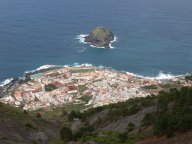 Though well worth a visit in its own right, a trip out to
Garachico is well worth while just for the
stunning views out to sea on one side of the road and on the
other side steep ravines cut into the hillside.
Though well worth a visit in its own right, a trip out to
Garachico is well worth while just for the
stunning views out to sea on one side of the road and on the
other side steep ravines cut into the hillside.
Garachico, together with Puerto de la Cruz (then known as Puerto de la Orotava), were the two main ports of the island, with Garachico being the more important. Garachico's pre-eminence came to an abrupt end in 1706 when El Teide erupted. Overnight the residents became interested in what was then a novel idea - house insurance. The plaques of London Insurance Companies can still be found on some of the old buildings.
Garachico has some of the finest old buildings and houses on the island. In the town square is a statue of Simón Bolívar (liberator and founder of modern Bolivia), commemorating that his Mother was born in Garachico. Offshore can be seen the Roque de Garachico - the legendary guardian of Garachico.
The name Icod de los Vinos is a combination of the Guanche word Benicod 'beautiful place', and the Spanish los vinos 'the wines'. As the name suggests an important wine growing area, the white is regarded by connoisseurs as the island's best. For the Guanches, this was a holy place where the Gods joined to create their race.
Icod is best known for its Dragon Tree, Drago Milenario. At 3,000 years old, claimed to be the oldest on the island. It used to be possible to go to Icod and see the tree, now it is surrounded by an ugly wall, and can only be viewed on the payment of an entrance fee. The wall is highly unpopular with local residents and tourists alike, and appears to have been erected without planning consent. Locals speak conspiratorially of corruption in the town hall. If ever there was a case for direct action, this is it. It can only be hoped that environmental activists turn up one night and with the help of local residents tear down the wall.
Apart from the famed Dragon Tree, Icod has several fine old buildings, particularly noteworthy are the convent of San Agustín and the Renaissance church of San Marcos in la Plaza de la Pila.
From Icod are some of the best views of El Teide.
The mountain road from Icod to Garachico passes through some magnificent pine forests. There are roadside picnic spots with signposted trails leading through the forest. Where the forest thins, the boulders are dripping with lichens indicating the lack of air pollution. Along the road at Tierra del Trigo there is a viewpoint giving stunning views of Garachico, Los Silos and along the coast. Built into and below the viewpoint is a teaching restaurant (RestauranteEscuela) Mirador Lomo Molino with panoramic views of the coast, the food is pretty good too. The road eventually descends in a tight zigzag down through a ravine to meet the Garachico to Buena Vista road near Buena Vista. Nerves of steel are required on the part of the driver as a momentary lack of concentration would take the car over the edge. The trip is not for the faint hearted. All along the mountain road are crosses and flowers marking past fatalities.
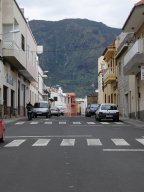 Tenerife's most westerly town. The town contains a number of 17th
and 18th century houses. Further on is Punta de Teno,
the island's most Westerly tip, regarded by the Guanches as the
end of the world.
Tenerife's most westerly town. The town contains a number of 17th
and 18th century houses. Further on is Punta de Teno,
the island's most Westerly tip, regarded by the Guanches as the
end of the world.
Against very strong opposition a golf course and hotel complex is being constructed at Buena Vista. This can only lead to the destruction of a relatively unspoilt part of Tenerife.
Punta de Teno, the most westerly point of Tenerife, lies beyond Buenavista. The road is narrow and winding with dramatic drops to the sea. The road can at times be closed during bad weather. There are frequent rock falls on the road. The road goes no further than Punta de Teno.
Approximately half-way along the road there is a small view point or mirador. From this windy vantage point there are stunning views along the coast.
The road goes through a 1km tunnel hewn into the rocks beyond the mirador. Once through the tunnel the vegetation and scenery changes. It is now typical of the south of the island.
There is a lighthouse at Punta de Teno with stunning views down the coast.
Looking out to sea on a clear day, La Gomera can be seen in the distance.
The rugged north western area of Tenerife, Macizo de Teno, is unspoilt and only accessible on foot. Within this area lies the small village of Masca, on the southern edge of Los Gigantes.
The massacre of Acentejo. In a local gorge in 1494 the Guanches inflicted a massive defeat on the Spanish. The commander Alonso Fernández de Lugo only escaped with his life by handing his red cloak to a soldier whom the Guanches killed.
The Victory of Acentejo. The year following his defeat, Lugo returned to exact his revenge. After a five hour bloody battle the Guanches were defeated. 5,000 Guanches lay dead, 64 Spanish.
La Victoria and La Matanza are twin towns that lie on the main road running alongside autopista del norte.
A picturesque small town with many examples of traditional Canarian architecture. St Peter's Church and the Chapel of Los Angeles, both date from the 16th century.
An important wine growing area. The wines and restaurants have an island wide reputation.
La Baranda a 17th century Canary estate dedicated to promoting the best is Canary wine. On the estate is La Casa de Vino, a museum which illustrates all aspects of wine growing, and includes a wine tasting room.
The Cueva de los Viejos (Old Men's Cave), out on the cliffs, used be to a guanche settlement.
The centre of the local wine growing area. Fine wines, excellent restaurants.
The town also has two fine churches - la Iglesia de Santa Catalina and la Iglesia del Cristo de los Dolores.
The airport is immediately adjacent to the motorway. It is only used for internal Spanish flights. It is easy to see why. Often misty with reduced visibility, the approaches are surrounded by mountains. In 1977 it was the scene of the world's worst air disaster. Two jumbo jets collided, killing 583 people. Prior to the building of Reina Sofia in the South, it was the island's main airport.
The original capital of the island, founded in 1496 by Alonso Fernández de Lugo. Many historic buildings, site of one of Spain's most prestigious university, 1701. The Astrophysics Department controls some of the world's most important telescopes. The town's cathedral, Santa Iglesia, was founded in 1515.
Formed in 1975, the Instituto de Astrofísica de Canarias is an astrophysical research institute based at the University of La Laguna. It operates two astronomical observatories in the Canary Islands, Roque de los Muchachos Observatory on La Palma and Observatorio del Teide on Tenerife.
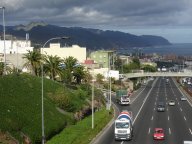 The island's capital, and the Canaries main port. Noisy, dirty, hot and
dusty. Many beggars on the streets. The bus station is on the
outskirts of town entailing a walk of about 10 - 20 minutes to
the town centre.
The island's capital, and the Canaries main port. Noisy, dirty, hot and
dusty. Many beggars on the streets. The bus station is on the
outskirts of town entailing a walk of about 10 - 20 minutes to
the town centre.
The biggest problem with a trip to Santa Cruz, unless you are an early riser, is that no sooner do you arrive than everything closes and doesn't come alive again until around 1600.
Santa Cruz's most notable name to fame is that this is the place where Nelson lost his arm, and was for Nelson the site of a rare defeat.
Santa Cruz is ringed by rugged mountains. Macizo de Anaga, a rugged, remote mountainous area, the north easterly tip of Tenerife. Still unspoilt and well worth exploring on foot. Chinamada has its origins in a Guanche settlement, and the people still live in caves. At Punta del Hidalgo it is possible to bathe in the waterfalls. On the southern coast, near San Andrés, is the popular man-made beach of Playa de las Teresitas. Punta de Anaga is the most easterly point in Tenerife.
On a clear day, on the motorway from Santa Cruz to the airport, there are views of Gran Canaria in the distance.
This is whence you came, and no doubt from where you will leave.
The grounds around the airport have been tastefully landscaped. The terminal building has been enlarged and the facilities and services much improved to what they were a few years ago.
A few minutes drive from the airport, heading towards Santa Cruz along the motorway, a large wind farm can be seen on the coast. A similar distance further along the motorway on the opposite side of the road is another large wind farm. The emergency telephones on the side of the motorway are solar powered.
From the airport to Santa Cruz the landscape is dry and arid, deeply carved by gullies.